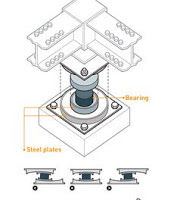Turkey’s Earthquake Proof Airport
 With the news this morning of major aftershocks being felt in Chile, many of us are questionning just how vulnerable our homes and buildings are.
With the news this morning of major aftershocks being felt in Chile, many of us are questionning just how vulnerable our homes and buildings are.
A while back, I blogged about the earthquake proof house.
Today, I thought I’d share a little bit about the earthquake proof airport.
The Sabiha Gökçen International Airport terminal in Istanbul opened on Halloween 2009 and is the largest “seismically-isolated” (aka earthquake-protected) building in the world.
 Designed by the engineering firm Arup and able to withstand an 8.0 magnitude earthquake, the 2 million square-foot terminal can absorb 80 percent of back-and-forth shaking, the most destructive movement. How? The building features a foundation with 300 dampers, each with a bearing sandwiched between sliding steel plates (see image).
Designed by the engineering firm Arup and able to withstand an 8.0 magnitude earthquake, the 2 million square-foot terminal can absorb 80 percent of back-and-forth shaking, the most destructive movement. How? The building features a foundation with 300 dampers, each with a bearing sandwiched between sliding steel plates (see image).
But why bother with such complex construction? Since Istanbul is located over three tectonic plates, a major earthquake is likely to occur in the near future — in fact, there’s about a 60 percent chance that an earthquake will level the city by 2040. An airport that’s still standing can be used to fly in emergency medical supplies and food, key components of disaster relief.
Hey Port of Portland, are you listening?
Thanks to Popular Science and Trendhunter for help!
5 comments
PopSci is the best!
Ok, so their airport is but what about all the mud brick villages?
Good point. We hope someday all buildings will be as safely constructed as this airport.
It was really shocking when Google Maps did their map update to show the damage in Haiti, and allowing one to see how the relief efforts were taking shape. They only had a few fairly minor airports, and you could even see helicopters parked on the dock nearest the US Embassy as opposed to the Port-au-Prince airport. It has since been updated again, and the airport is clearly where the tent city of relief workers is staged. Airport survival is vital for any disaster.
The construction of a terminal that can withstand an earthquake of that size is a great accomplishment, but I am a bit worried because I could not find any information about how earthquake proof the runway is. Any damage to an airport runway will prevent planes from landing regardless of what shape the terminal is in.
If the runway is intact but the terminal is not, a ham radio could be used to communicate with planes if there were not other options (note: use of those frequencies is not in compliance with ham radio licenses)
I hope that they took all of this into consideration when they choose to earthquake proof the terminal and leave the runway to the mercy of the earth.
Comments are closed.